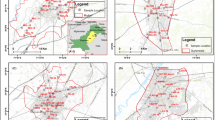Abstract
Groundwater plays a major life support to mankind. It is the major source to meet the domestic, irrigation and industrial water demands. The depletion of groundwater through excessive consumption and less recharge in the study area has detoriated the quality of groundwater. The present study has analyzed the pre- and post-monsoon physicochemical data of groundwater samples from 49 different bore wells in Virudunagar district. Spatial distribution maps were prepared for various physicochemical parameters using geographic information system. These maps are further classified according to highest desirable, maximum permissible and not permissible prescribed by the World Health Organization. Furthermore, a water quality index (WQI) map was also generated to understand the groundwater quality in the study area. It was observed that the groundwater in the area is hard and alkaline in nature and the WQI reveals that most part of the study area fall under fair water quality class. Also, the effect of recharge during monsoon period has diluted the geochemistry of the groundwater. The application of GIS and WQI in the study area is a promising tool to understand the spatial pattern of groundwater quality and its management.














Similar content being viewed by others
References
APHA (1995) Standard methods for the examination of water and waste water, 19th edn. American Public Health Association, Washington
Azeez PA, Nadarajan NR, Mittal DD (2000) The impact of monsoonal wetland on groundwater chemistry. Pollut Res 19(2):249–255
Back W (1996) Hydrochemical facies and groundwater flow patterns in the northern part of the Atlantic Coastal Plain. USGS Prof. Paper 498-A
Bhardwaj V, Singh DS, Singh AK (2010) Hydrgeochemistry of a plain, India. Environ Earth Sci 59:1099–1109
Burrough PA, McDonnell RA (1998) Principles of geographical information systems. Oxford University Press, Oxford, p 333
Canadian Council of Ministers of the Environment (CCME) (2001) Canadian Water Quality Guidelines for the Protection of Aquatic Life: CCME Water Quality Index 1.0, Technical Report, Canadian Council of Ministers of the environment, Winnipeg, MB, Canada. Available at:http://www.ccme.ca/sourcetotap/wqi.html
Causape J, Auque L, Gimeno MJ, Mandado J, Quilez D, Aragues R (2004) Irrigation effects on the salinity of the Arba and Riguel Rivers (Spain): present diagnosis and expected evolution using geochemical models. Environ Geo 45:703–715
CPCB (2008) Guidelines for water quality management. Central Pollution Control Board, Parivesh Bhawan, East Arjun Nagar, Delhi
Drever JI (1982) The geochemistry of natural waters. Prentice-Hall, Englewood Cliffs
Elhatip H, Afsin M, Kuscu L, Dirik K, Kurmac A, Kavurmac M (2003) Influences of human activities and agriculture on groundwater quality of Kayseri-Incesu-Dokuzpinar springs central Anatolian part of Turkey. Environ Geol 44:490–494
Freeze RA, Cherry JA (1979) Groundwater. Prentice-Hall, New Jersey
Fytianos K, Christophoridis C (2004) Nitrate, arsenic and chloride pollution of drinking water in Northern Greece: elaboration by applying GIS. Environ Monit Assess 93:55–67
Gupta S, Mahato A, Roy P, Datta JK, Saha RN (2008) Geochemistry of groundwater, Burdwan district, West Bengal, India. Environ Geol 53:1271–1282
Jeong CH (2001) Effect of land use and urbanization on hydrochemistry and contamination of groundwater from Taejon area, Korea. J Hydrol 253:194–210
Krishna Kumar S, Chandrasekar N, Seralathan P, Godson PS, Magesh NS (2011) Hydrogeochemical study of shallow carbonate aquifers, Rameswaram Island, India. Environ Monit Assess. doi:10.1007/s10661-011-2249-6
Lee SM, Min KD, Woo NC, Kim YJ, Ahn CH (2003) Statistical models for the assessment of nitrate contamination in urban groundwater using GIS. Environ Geol 44:210–221
Lumb A, Halliwell D, Sharma T (2006) Application of CCME water quality index to monitor water quality: a case of the Mackenzie River basin, Canada. Environ Monit Assess 113:411–429
Magesh NS, Chandrasekar N, Soundranayagam JP (2011a) Morphometric evaluation of Papanasam and Manimuthar watersheds, parts of Western Ghats, Tirunelveli district, Tamil Nadu, India: a GIS approach. Environ Earth Sci 64:373–381
Magesh NS, Chandrasekar N, Vetha Roy D (2011b) Spatial analysis of trace element contamination in sediments of Tamiraparani estuary, southeast coast of India. Estuar Coast Shelf Sci 92:618–628
Mouna K, Moncef G, Rachida B (2011) Use of geographical information system and water quality index to assess groundwater quality in El Khairat deep aquifer (Enfidha, Central East Tunisia). Arabian J Geosci. doi:10.1007/s12517-011-0292-9
Narayana A, Suresh G (1989) Chemical quality of groundwater of Mangalore City, Karnataka. Indian J Environ Health 31(3):228–236
Nash H, McCall GJH (Ed.) (1995) Groundwater quality. In: 17th Special Report. Chapman and Hall, London
Piper AM (1944) A graphical interpretation of water analysis. Trans Am Geophys Union 25:914–928
Prasad RK, Mondal NC, Pallavi B, Nandakumar MV, Singh VS (2008) Deciphering potential groundwater zone in hard rock through the application of GIS. Environ Geol 55:467–475
Saleem R (2007) Groundwater management—emerging challenges. Water Digest
Sawyer CN, McCarty PL (1967) Chemistry for sanitary engineers, 2nd edn. Mc-Graw Hill, New York, p 518
Sawyer CN, McCarty PL (1978) Chemistry for environmental engineering. Mc-Graw Hill, New York, p 532
Subba Rao N, Surya Rao NV, Chandu SN (1996) Characterization of groundwater contamination using factor analysis. Environ Geol 28(4):175–180
Walter MF, Bubenzer GD, Converse JC (1975) Predicting vertical movement of manorial nitrogen in soil. Trans Am Soc Agricult Eng 18:100–105
Ward CF (1994) Impact of human activity on groundwater quality in rural areas. Chapman and Hall, London, pp 109–111
WHO (2004) Guidelines for drinking water quality, 3rd edn. World Health Organization, Geneva
Author information
Authors and Affiliations
Corresponding author
Rights and permissions
About this article
Cite this article
Magesh, N.S., Chandrasekar, N. Evaluation of spatial variations in groundwater quality by WQI and GIS technique: a case study of Virudunagar District, Tamil Nadu, India. Arab J Geosci 6, 1883–1898 (2013). https://doi.org/10.1007/s12517-011-0496-z
Received:
Accepted:
Published:
Issue Date:
DOI: https://doi.org/10.1007/s12517-011-0496-z




